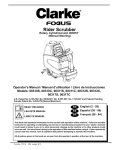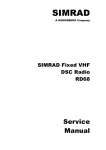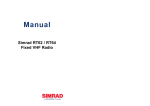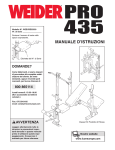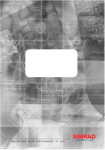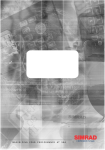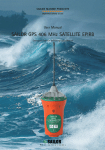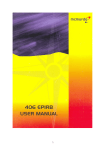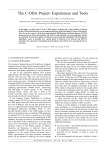Download Simrad RD68 Instruction manual
Transcript
M A X I M I Z I N G Y O U R P E R F O R M A N C E A T S E A Instruction Manual M A N U A L Simrad RD68 Fixed DSC VHF Radio III RD68 VHF © 2005 Simrad Ltd The technical data, information and illustrations contained in this publication were to the best of our knowledge correct at the time of going to print. We reserve the right to change specifications, equipment, installation and maintenance instructions without notice as part of our policy of continuous development and improvement. No part of this publication may be reproduced, stored in a retrieval system, or transmitted in any form, electronic or otherwise without prior permission from Simrad Ltd. No liability can be accepted for any inaccuracies or omissions in the publication, although every care has been taken to make it as complete and accurate as possible. IV Part No. E03912 Issue 2.0 14-Feb-05 CR/MDL Instruction Manual 1 GENERAL 1.1 1.2 1.3 1.4 Introduction ........................................................................... Licensing ............................................................................... Entering MMSI numbers ....................................................... Group ID MMSI .................................................................... 7 8 9 10 2 OPERATION 2.1 2.2 2.3 2.4 General .................................................................................. Rotary controls ...................................................................... Backlighting .......................................................................... Changing channels ................................................................ 2.4.1 Standard International channels .................................. 2.4.2 Auxiliary & Private channels ...................................... 2.5 Transmit power ...................................................................... 2.6 Making a DSC call ................................................................ 2.7 Making a Distress Alert call ................................................ 2.8 Receiving a DSC call ............................................................ 2.9 Dual Watch ............................................................................ 2.10 Tri-Watch ............................................................................. 2.11 Scan mode ............................................................................ 2.11.1 Inhibiting channels from scan ................................... 2.12 Memory Scan ...................................................................... 2.12.1 Add/remove channels from Memory Scan ............... 2.13 Priority & User channel select ............................................ 2.13.1 Programming the User channel ................................ 2.14 Viewing the call log ............................................................. 11 11 12 12 12 13 14 14 17 19 20 21 22 22 23 24 25 25 26 3 MISCELLANEOUS FUNCTIONS 3.1 3.2 3.3 3.4 Adjusting the LCD contrast ................................................... Entering position and time manually .................................... Entering local time ................................................................ Viewing the directory ............................................................ 3.4.1 Adding an entry to the directory ................................. 3.4.2 Editing/deleting an entry ............................................. 3.5 Disabling the key beep .......................................................... 3.6 Second country mode ............................................................ 3.7 Speaker mute (handset models only) .................................... 27 28 30 31 32 33 35 36 36 4 INSTALLATION 4.1 VHF installation .................................................................... 4.2 Antenna installation .............................................................. 4.3 Electrical interference suppression ........................................ 37 40 42 V RD68 VHF 5 APPENDIX 5.1 Operating procedures ............................................................. 5.1.1 Sending a Distress Alert .............................................. 5.1.2 Acknowledging and relaying a Distress Alert ............ 5.1.3 Cancelling a Distress Alert ......................................... 5.1.4 Alerting all vessels within range ................................. 5.1.5 Calling a coast radio station ........................................ 5.1.6 Making an intership call ............................................. 5.2 NMEA sentences received ..................................................... 5.3 Transmission range ................................................................ 5.4 Channel frequencies .............................................................. 5.5 Troubleshooting ..................................................................... 5.6 Accessories ............................................................................ 5.7 Technical specifications ......................................................... 5.8 Dimensions ............................................................................ 5.9 Declaration of Conformity .................................................... 5.10 Service & Warranty ............................................................. VI 43 43 43 44 44 44 44 44 45 46 47 48 48 49 50 51 E03912 Issue 2.0 Instruction Manual 1 GENERAL 1.1 Introduction The RD68 is a combined VHF radio and Class D Digital Selective Calling (DSC) unit. It supports the latest GMDSS requirements for non-SOLAS vessels from the International Maritime Organization (IMO). This will enable you to make digitally selected calls, which are quicker and simpler to make than traditional voice calls using channel 16. Should a distress situation occur, with the RD68 you can quickly raise an alert, indicating your identity, your position, and automatically establish distress communication on the emergency voice channel. The RD68 is robustly constructed using a pressure die-cast aluminum case for effective heat dissipation, ensuring maximum transmission performance even after many hours’ constant use. Thank you for choosing Simrad! If you are pleased with your VHF, we hope you will be interested in our range of marine electronic equipment, which is manufactured to the same high standards as the RD68. Please contact your nearest Simrad Agent for a catalog showing our increasing range of high tech navigational instruments, GPS, Autopilots, Radar, Fishfinders and VHF radio sets. Simrad operates a policy of continual development and reserves the right to alter and improve the specification of their products without notice. Fig 1.1 - RD68 combined VHF & DSC E03912 Issue 2.0 7 RD68 VHF 1.2 Licensing Note Prior to use please check the national licensing requirements for operators. In the UK license applications and queries should be made to the following authority: Ship Radio Licencing Radio Licencing Centre The Post Office PO Box 1495 Bristol BS99 3QS Website: www.radiolicencecentre.co.uk/rlc A set may only be operated by or under the supervision of the holder of a Marine Radio Operator’s Certificate of Competence and Authority to Operate. This is awarded on completion of the Marine Short Range Certificate course administered by the Royal Yachting Association: Royal Yachting Association RYA House Ensign Way Hamble Southampton SO31 4YA Website: www.rya.org.uk Tel. 0845 345 0400 Holders of the Restricted Certificate of Competence in Radiotelephony (which covers MF/HF SSB, etc.) do not need a separate VHF certificate. In all other countries, please contact your regional authority for information. Note North American Users – To meet FCC (Federal Communications Commission) rules on Radio Frequency Exposure, it is recommended that the VHF antenna is mounted at least 3 m (10 ft) away from any area accessible to any personnel on board. If this distance is achieved by vertical separation, the antenna must be at least 5 m (16.5 ft) above deck. This guideline applies only to antennas not exceeding 9dBi gain. WARNING Failure to observe these recommendations may expose those within the MPE (maximum permitted exposure) radius of 3 m (10 ft) to RF absorption levels that exceed the FCC safe limits. 8 E03912 Issue 2.0 Instruction Manual 1.3 Entering MMSI numbers At the time of issue of your vessel’s radio license, an MMSI (Maritime Mobile Service Identifier) must be requested. This is a nine-digit number which must be permanently entered into the RD68 when the radio is first set up, otherwise the DSC functions cannot be accessed. Note If the boat or the RD68 are subsequently sold, the radio must be returned to an authorized Simrad agent for the MMSI number to be erased and the new owner’s MMSI number entered. ➞ For licensing details, please refer to section 1.2. To enter the vessel’s MMSI number: 12:43 DSC INT T/W Hi Lite M/S Scan Rx 12:43 52o16N 001o23E Rx Rad Menu 12:43 52o16N 001o23E Rx DSC LCD Posn More /continued E03912 Issue 2.0 9 RD68 VHF 52o16N 001o23E Rx DSC MMSI Dir More 12:44 Ships MMSI ********* Group MMSI 000000000 DSC Press this key to enter the MMSI number Press this key to enter the Group ID 12:44 Enter the MMSI number using the keypad. Press E to enter Note Ships MMSI 002325___ DSC If an error is made, press to move back and edit the number. You will be asked to confirm the number. Re-enter the MMSI and press E. CAUTION It is important that the MMSI entered is checked carefully, as it can only be entered once. To change the MMSI number after it has been programmed, the unit must be returned to an authorized Simrad Dealer to erase the existing number. 1.4 Group ID MMSI For boats that are part of a flotilla, racing fleet, or other group, a Group ID MMSI number can also be entered while in the MMSI entry screen by pressing softkey 4. Follow the procedure described above to enter the Group MMSI. Unlike the vessel MMSI number, this can be changed later by the user. 10 E03912 Issue 2.0 Instruction Manual 2 OPERATION 2.1 General The RD68 VHF is very simple to operate, with the controls falling into five groups: 1 SOFTKEY LABEL SOFTKEY LABEL SOFTKEY LABEL SOFTKEY LABEL SC1 SC2 SC3 SC4 2 3 4 Softkeys & labels 1. The rotary Volume (On/Off) & Squelch controls. 2. The alphanumeric keypad used to select the channel, MMSI number, etc. 3. The dedicated controls, for commonly used functions such as output power, Dual Watch, and channel 16 select, etc. 4. The four softkeys to the right of the display are multifunction keys whose function changes depending on which menu is displayed. The label showing the current function for each softkey appears on the right side of the display (see left). 5. There is also a Distress button under a sliding cover. This must only be used in an emergency (see section 5.1). The radio functions are split into two main modes: • Radio mode allows access to the standard VHF radio functions, such as Tri-Watch, scanning, etc. • DSC mode covers the digital selective calling functions. These modes are toggled by pressing softkey 1 (labeled DSC or RAD). At any stage of the DSC mode menu structure, pressing the DSC softkey will return to the DSC mode main menu. At any stage of the DSC mode menu structure, pressing the C key will cancel any unconfirmed action, or step back one level in the menu structure. Note Some menu options will only be displayed if the relevant information is available. If the radio is receiving NMEA GPS data, the current Lat/Long will be displayed when in DSC mode, and the time will be displayed in both Radio and DSC modes in 24-hour UTC (GMT) format (the local time can also be entered). 2.2 Rotary controls Switch the radio on by turning the VOLUME knob clockwise. To increase the volume, turn the knob further clockwise. Turn the knob fully counterclockwise to switch off. The SQUELCH knob is used to adjust the receiver muting threshold (squelch) level. To cut out weaker signals, increase the squelch until the background interference noise disappears. To receive weaker signals, decrease the squelch. E03912 Issue 2.0 11 RD68 VHF 2.3 Backlighting ( ) 12:40 INT Hi Lite Rx DSC T/W M/S Scan There are five levels of brightness – press and hold the key to step through and release when the required level is shown. 2.4 Changing channels 2.4.1 Standard International channels 12:40 Enter the channel number using the numeric keypad INT Pvt Wx Hi Lite Aux Rx Aux 12:41 If channel selection is not confirmed within 2 seconds (by pressing E), the radio will revert to the original channel Note 12 INT Hi Lite Rx DSC T/W M/S Scan To select channels, the RD68 will need to be in Radio mode. If in DSC mode, press the RAD softkey before entering the channel number. E03912 Issue 2.0 Instruction Manual 2.4.2 Auxiliary & Private channels This function is used to select channels which are not part of the standard International channel set, for example, channels M and M2 in the UK, or the US Wx Weather channels. Standard availability of channels includes M & M2 in the UK, or one or more of L1–L3 or F1–F3 in Scandinavia (cf. section 5.3). Note STEP 1 To select an Auxiliary channel press any numeric key – To select a Weather or Private channel, press the relevant number key (e.g. 2 for Private Ch2 or Weather Ch2 – 12:41 INT Pvt Wx Hi Lite Aux Rx Aux 12:41 INT Pvt Wx Hi Lite Aux Rx Aux STEP 2 (Private) Press Pvt to select Private Ch2 STEP 2 (Weather) Press Wx to select Weather Ch2 12:42 INT Pvt Wx Hi Lite Aux Rx Aux STEP 2 (Auxiliary) Press Aux▲ or Aux▼ to scroll through the available Auxiliary channels & press E to select E03912 Issue 2.0 12:42 INT Pvt Wx Hi Lite Aux Rx Aux 13 RD68 VHF 2.5 Transmit power This function allows toggling of the transmit power between 25W (Hi) and 1W (Lo) for short range transmissions, for example, when in a marina. This preserves battery power. 12:42 INT Hi Lite Rx DSC T/W M/S Scan 12:42 INT Lo Lite Rx Note DSC T/W M/S Scan Regulations restrict some channels, such as 15 and 17, to low power only, in which case this key will have no effect. 2.6 Making a DSC call Press the DSC softkey to enter DSC mode: 12:43 DSC INT T/W Hi Lite M/S Scan Rx /continued 14 E03912 Issue 2.0 Instruction Manual 12:43 52o16N 001o23E Rx SELECTING CALL TYPE Press Type to scroll through the different types of calls (see also p. 16): Rad Call Menu MANUAL ENTRY To manually enter an MMSI number (Routine call): 12:43 12:43 Routine to Excalibur Rx Type Dir Ch26 Send Routine to ________ Usekey to correct any mistakes Rx Use keypad to type in MMSI number and press E, then Send 12:43 All Ships Safety Rx Type Ch16 Send 12:43 Routine to 002325567 On Ch26 Press E to send 12:43 All Ships Urgency Rx Type 12:43 Ch16 Send Waiting for acknowledge Rx Press Stop to cancel call 12:44 Group call 009999999 Rx Type Ch26 Send Select call type and press Send to transmit E03912 Issue 2.0 Stop Only displayed if a Group MMSI number has been entered (see section 1.3) /continued 15 RD68 VHF 12:44 52o16N 001o23E Rx MMSI DIRECTORY Use the directory (see section 3.4) to select a commonly used MMSI: Rad Call Menu VOICE CHANNEL SELECTION To specify which channel is to be used in voice communication 12:44 Routine to Excalibur Rx Type Dir Ch26 Send Press Dir to scroll through directory entries Press softkey 3 (ChXX) to specify voice channel. 12:44 Routine to Hbrmaster Rx Type Dir Ch26 Send 12:43 Routine to Hbrmaster On Ch26 Press E to send 12:45 Press Send to transmit call Routine to Excalibur Rx Type Dir Ch26 Send Voice channel can only be specified on Routine, Safety and Group calls (simplex only). Urgency and Distress calls are set to Ch16. When making a Routine call to a coast station (MMSI begins with “00”), the option to select a voice channel is not available. 12:45 12:43 Waiting for acknowledge Rx Press Stop to cancel call 16 Reply on channel 17 Rx Stop Chan Press Chan to scroll through a selection of pre-programmed channels, or type in the channel number and press E. E03912 Issue 2.0 Instruction Manual 2.7 Making a Distress Alert call WARNING This call should only be made if the vessel is in a genuine distress situation. It is an offense to send a Distress Alert call if the vessel or crew are not in grave and imminent danger (see section 5.1). The DISTRESS button is located under a protective cover that must be slid back before the button can be pressed. Press the DISTRESS button to access the Distress Alert screen: 12:46 Distress Alert 52o16N 001o23E 12:46 UTC Undefined 12:46 Distress Alert 52o16N 001o23E 12:46 UTC Abandoning Collision Grounding Piracy Listing M.O.B Sinking Fire Adrift Flooding Pressto scroll through distress categories /continued E03912 Issue 2.0 17 RD68 VHF 12:47 DISTRESS ALERT Sending in 5 secs To send the call, press and hold the DISTRESS key for five seconds. A countdown to the transmission will be displayed. Release the key at any time during this countdown to abort the transmission and press C to return to the main menu. The Distress Alert transmission contains the following data: • The vessel’s MMSI • The vessel’s position (either from the NMEA 0183 input, or manually entered) • The time (from NMEA or manual) • The nature of the distress Note If the boat’s position and time are not being received via the NMEA interface, then the display will allow this data to be entered manually (refer to section 3.2 for more details). After the Distress Alert has been sent, the RD68 will tune to channel 16 and will automatically repeat the alert approximately every four minutes, until either an acknowledgment is received or C is pressed (it is not recommended that the Distress Alert is cancelled manually by pressing C, unless you are requested to do so by the rescue authorities). While the Distress Alert remains active, an intermittent alarm will continue to sound. When an acknowledgment is received from the Rescue Coordination Center, this will automatically cancel the Distress Alert transmission. The subsequent rescue co-ordination will be performed using the voice working channel. 18 E03912 Issue 2.0 Instruction Manual 2.8 Receiving a DSC call When a call is received, the RD68 will ring and the display will show the call information. Press Ack (for individual calls requesting acknowledgment only) or OK to cancel and switch to the working channel. Press Stop to cancel ring only. Individual Routine call Individual Routine call from MMSI stored in directory 12:48 12:48 Ack Individual Routine Stop From 987654321 Ch06 Ack Individual Routine Stop From Excalibur Ch06 All Ships Safety call All Ships Urgency call 12:48 12:48 OK All Ships Safety Stop From 987654321 Ch16 OK All Ships Urgency Stop From 987654321 Ch16 Group call Distress Alert call 12:50 12:50 OK Group call Routine Stop From Excalibur Ch06 Distress OK Alert From 987654321 Ch16 Press ▼ key for more information 12:50 Sinking 23o47’N 001o35’E 12:50 UTC E03912 Issue 2.0 OK 19 RD68 VHF 2.9 Dual Watch Dual Watch allows the radio to scan between a selected working channel and the priority channel (normally Ch16). 12:52 Select a working channel INT Hi Lite Rx Press the D/W key INT Hi Lite Rx DSC T/W M/S Scan 12:52 DSC T/W M/S Scan 12:52 12:52 INT DSC Hi Ch16 D/W INT DSC Hi Ch16 D/W The RD68 will monitor the working channel and the priority channel sequentially Note 20 Normal VHF functions will not be available when in Dual Watch mode. To change channel or transmit, press 16, D/W, or C to exit Dual Watch. DSC functions can still be accessed by pressing DSC; however, sending a DSC call will automatically cancel Dual Watch. E03912 Issue 2.0 Instruction Manual 2.10 Tri-Watch Tri-Watch operates on the same principle as Dual Watch, but this function scans between the working channel, priority channel, and the User channel. For more information on the User channel and how it is specified, please refer to section 2.13. 12:53 Select a working channel and press the T/W key INT Hi Lite Rx DSC T/W M/S Scan 12:53 INT DSC Adv Hi Ch16 T/W 12:53 12:53 INT DSC Adv Hi Ch16 T/W INT DSC Adv Hi Ch16 T/W 12:54 Pressing Adv will manually advance the scan onto the next channel in the sequence Note E03912 Issue 2.0 INT DSC Adv Hi Ch16 T/W As with Dual Watch, normal VHF functions will not be available when in Tri-Watch mode. Exit Tri-Watch by pressing 16 or C. 21 RD68 VHF 2.11 Scan mode The Scan function cycles the RD68 sequentially through each enabled channel, pausing when a signal is detected. 12:54 INT Hi Lite Rx DSC T/W M/S Scan 12:54 Press Adv to manually advance to the next channel in the scan sequence Note INT DSC Hi Lite Inh Scan Adv While in Scan mode, normal VHF functions are not available. To exit Scan mode, press C or 16. 2.11.1 Inhibiting channels from scan In some areas the Scan function may repeatedly lock on a channel at each cycle, for example, if it is transmitting a carrier signal. Rather than pressing Adv each cycle, selected channels may be inhibited from the scan cycle. 1. While in Scan mode 2. In VHF mode 12:55 INT DSC Scan Inh Inh Scan Adv 12:55 INT Scan Inh Rx DSC T/W M/S Scan Select channel to be inhibited, then press and hold Scan (double beep) Press and hold 22 E03912 Issue 2.0 Instruction Manual To re-enable an inhibited channel into the scan cycle, repeat sequence 2: 12:55 Select channel to be enabled then press and hold Scan (double beep) INT Scan Ena Rx DSC T/W M/S Scan Press and hold 2.12 Memory Scan Like the Scan function, Memory Scan will cycle sequentially through the channels, but only those which have been preselected. ➞ Refer to the next subsection 2.12.1 for more information on preselecting Memory Scan channels. 12:55 INT DSC T/W Hi Lite M/S Scan Rx 12:56 Press Adv to manually advance to the next channel in the Memory Scan sequence Note E03912 Issue 2.0 INT DSC Hi Lite Adv M/S Del While in Memory Scan mode, normal VHF functions are not available. To exit Memory Scan mode, press C or 16. 23 RD68 VHF 2.12.1 Add/remove channels from Memory Scan To add a channel to the Memory Scan cycle: 12:57 Select the required channel INT Hi Lite Rx DSC T/W M/S Scan 12:57 INT DSC M/S T/W Sel M/S Rx Scan Press and hold M/S (double beep) Press and hold To delete a pre-selected channel from the Memory Scan cycle: 1. While in Memory Scan mode INT M/S Del M/S 2. In VHF mode 12:57 12:57 DSC INT DSC M/S T/W Del M/S Rx Scan Adv Del Select channel to be deleted, then press and hold M/S (double beep) Press and hold 24 E03912 Issue 2.0 Instruction Manual 2.13 Priority & User channel select The priority channel (usually Ch16, depending on the configuration of the RD68) can be accessed immediately by pressing 16. This will cancel any function currently in operation. The User channel is a programmable priority channel which is accessed by pressing 16 twice: 12:57 INT Hi Lite Rx DSC T/W M/S Scan Press 16 twice 12:58 INT Hi User Rx DSC T/W M/S Scan 2.13.1 Programming the User channel 12:58 Select the required channel Press and hold T/W (double beep) INT DSC T/W Hi Lite M/S Rx Scan Press and hold 12:58 INT User Sel M/S E03912 Issue 2.0 DSC T/W M/S Scan 25 RD68 VHF 2.14 Viewing the call log The last 16 incoming DSC calls are logged by the RD68 and can be viewed later (this function will not be displayed if no calls have been received). 12:58 52o16N 001o23E Rx Rad Call Log Menu 12:58 The most recent call is shown first Individual Routine From 987654321 DSC Back 12:59 All Ships Safety From 987654321 DSC Back Next 12:59 Press ▼ to view any extra information Distress Alert From 987654321 DSC Back Next 12:59 Sinking 23o47’N 001o35’E 12:50 UTC 26 DSC Back Next E03912 Issue 2.0 Instruction Manual 3 MISCELLANEOUS FUNCTIONS 3.1 Adjusting the LCD contrast 13:00 52o16N 001o23E Rx Rad Call Log Menu 13:00 52o16N 001o23E Rx Press ▲ and ▼ keys to adjust contrast: max = +7 min = –8 DSC LCD Posn More 13:00 Contrast +2 DSC Rx Press DSC to return to main menu or C to cancel E03912 Issue 2.0 27 RD68 VHF 3.2 Entering position and time manually The boat’s position and the time (transmitted as part of a Distress Alert call) would normally be given by an interfaced GPS. If this is not available, the information can be manually entered: If no GPS information is being received, the clock is not shown and the display shows “No position available” No position Rad available Call Log Menu Rx No position available Rx DSC LCD Posn More 99o99 999o99 88:88 UTC DSC Posn UTC Enter Lat and Long using the keypad -o--+ ---o--+ 88:88 UTC DSC Press N or S for Latitude 52o16 ---o--+ 88:88 UTC UTC 13:02 N S /continued 28 E03912 Issue 2.0 Instruction Manual Press E or W for Longitude reference from meridian 52o16N 001o23 88:88 UTC Press E (Enter) key to confirm position and select time 52o16N 001o23E -:-- UTC Enter UTC time (24-hour format) using keypad and press E to confirm E W DSC Posn 52o16N 001o23E 13:02 UTC 52o16N 001o23E 13:02 UTC DSC Posn UTC Note The display will now show the manual Lat and Long when in DSC mode, but the clock display will not be shown (this is only available if NMEA position and time data is being received). Note This option will not be available if position and time data is being received via the NMEA input. If this option is used, the RD68 will request that the position and time be updated regularly E03912 Issue 2.0 POSITION IS OVER 4 HOURS OLD Rad Posn 29 RD68 VHF 3.3 Entering local time When a GPS is connected to the RD68 via the NMEA interface, the display will show the UTC (GMT) time in the top righthand corner. This can be changed to the local time if required: 13:03 52o16N 150o23E Rx Rad Call Log Menu 13:03 52o16N 150o23E Rx DSC LCD Posn More 13:03 52o16N 150o23E Rx DSC MMSI Dir More 13:03 52o16N 150o23E Rx DSC Beep Time 13:03 Use arrow keys to adjust to local time and press DSC to return to main menu Adjust local time DSC Rx /continued 30 E03912 Issue 2.0 Instruction Manual 18:03 The display will now show local time 52o16N 150o23E Rx Rad Call Log Menu 3.4 Viewing the directory The directory allows up to 16 MMSI numbers to be stored in the RD68’s memory. These can then be recalled when making an Individual Routine call: 18:03 52o16N 150o23E Rx Rad Call Log Menu 18:04 52o16N 150o23E Rx DSC LCD Posn More 18:04 52o16N 150o23E Rx DSC MMSI Dir More 18:04 The main directory screen shows the number of directory entries Directory Used 04/16 DSC View Add /continued E03912 Issue 2.0 31 RD68 VHF 18:04 Directory 01 Excalibur 002321167 DSC Next Edit 18:04 Directory 02 Saucy Sue 002320588 DSC Back Next Edit 3.4.1 Adding an entry to the directory 18:05 Directory Used 04/16 Enter name using the keypad (10 chars max) - DSC View Add 18:05 Name: _________ DSC Press E to confirm name - 18:06 Enter MMSI number, then press E to save entry to directory 32 Name: Sea Mist MMSI: ________ DSC E03912 Issue 2.0 Instruction Manual 3.4.2 Editing/deleting an entry To edit an existing entry: 18:06 The main directory screen shows the number of entries Directory Used 05/16 DSC View Add 18:06 Directory 01 Excalibur 002321167 DSC Next Edit 18:06 Directory 01 Excalibur 002321167 DSC Del Edit MMSI number 18:06 Re-enter the MMSI using the keypad. Press E to enter Name: Excalibur MMSI: 00 ______ DSC Edit Name 18:06 Re-enter the name using the keypad. Press E to enter E03912 Issue 2.0 Name: Ba _______ MMSI: 002321167 DSC 33 RD68 VHF To delete an entry from the directory: 18:06 Directory Used 05/16 DSC View Add 18:07 Directory 01 Excalibur 002321167 DSC Next Edit 18:07 Directory 01 Excalibur 002321167 DSC Del 18:07 Directory Delete ? Excalibur 002321167 34 DSC No Yes E03912 Issue 2.0 Instruction Manual 3.5 Disabling the key beep All key presses on the RD68 are normally confirmed by a “beep” – this feature can be disabled: 18:07 52o16N 150o23E Rx Rad Call Log Menu 18:07 52o16N 150o23E Rx DSC LCD Posn More 18:07 52o16N 150o23E Rx DSC MMSI Dir More 18:07 52o16N 150o23E Rx DSC Beep Time To re-enable the key beep, repeat the above key sequence. Note E03912 Issue 2.0 The key beep will be disabled on all first level functions. Second level functions which are accessed by pressing and holding a key (e.g. setting the User channel or adding a channel to the Memory Scan cycle) will still be audibly confirmed by a double beep – this cannot be disabled. 35 RD68 VHF 3.6 Second country mode In countries where it is permitted, the RD68 can operate on a secondary set of channels, such as the USA channels: Radio switched off Press and hold 18:07 Turn radio on USA DSC M/S T/W Sel M/S Rx Scan Note Channel sets available will depend on programming. Please enquire with your national licensing authority for details of permitted channel sets in your country (see also section 5.4). Note The radio will revert to the International channel set when it is switched off. 3.7 Speaker mute (handset models only) On radios fitted with a handset, lifting the handset from the cradle will normally mute the loudspeaker. However, this can be disabled, so that the loudspeaker will remain on when the handset is lifted, and incoming transmissions will be heard both in the handset earpiece and the loudspeaker. Press and hold Radio switched off Turn radio on To restore speaker muting, repeat the above procedure. 36 E03912 Issue 2.0 Instruction Manual 4 INSTALLATION 4.1 VHF installation The radio should be sited so that engine noise and vibration or other background noise do not make it difficult for the operator to hear. Although the RD68 radio is waterproof when flush mounted, it is recommended that it is not installed where it will be exposed to continuous direct sunlight, as this will eventually damage the LCD display. As microphones and loudspeakers contain powerful magnets, the radio should not be installed within 1 m (3 ft 3 in) of any compasses, whether magnetic or electronic. The fins on the back of the case act as a heatsink to dissipate heat generated by the set when in use, which maintains the high efficiency of the radio. The free circulation of air is essential – when mounting the radio in an enclosed space, ensure that the space is vented. Desktop mounting Overhead mounting Fig 4.1 - Standard mounting options 88 mm (3.5 in) The VHF is supplied with a reversible mounting bracket. This can be used to mount the VHF on the chart table or on an overhead bulkhead (Fig 4.1). The bracket is fixed in place using four No. 10 x 3/4 in screws (supplied). Before installing, ensure that there is at least 88 mm (3.5 in) vertical clearance and 100 mm (3.9 in) horizontal clearance behind the bracket to allow the radio to fit (Fig 4.2). 100 mm (3.9 in) Fig 4.2 - Minimum clearance required E03912 Issue 2.0 37 RD68 VHF The radio is fixed to the bracket using a simple clamp arrangement. The peg on the left side of the radio is slotted into the hole in the bracket. The clamp on the right side of the radio can then be slid into the slotted aperture on the bracket and tightened to hold the radio firmly in place (Fig 4.3). The rake angle of the radio can be adjusted by slackening the clamp. 3 1 2 1. Fit locating peg (left side) into hole in bracket 2. Slide locking clamp (right) into slot in bracket 3. Tighten clamp Fig 4.3 - Fixing the VHF to the bracket An alternative mounting method is to use the flush mounting kit (FMB1000:BK, supplied separately). This allows the radio to be neatly installed inside a bulkhead, so that only the fascia of the radio is visible. ➞ For more details of this and other accessories available, please refer to section 5.6. 38 E03912 Issue 2.0 Instruction Manual The RD68 has five electrical connections – the handset/fistmike socket is on the front panel below the LCD display (Fig 4.4A). The other four are situated on the back of the case: the antenna socket is on the left (Fig 4.4B); DC power is supplied to the set via a two-core flying lead (Fig 4.4C); the NMEA input connections (Fig 4.4D) allow a GPS to be interfaced, below which is a 3.5 mm jack socket for an optional extension speaker (Fig 4.4E) – this is covered by a weather plug when not in use. C - 12V DC A - Handset / Fistmike D - NMEA E - Extension speaker B - Antenna Fig 4.4 - External connections The VHF requires a 12 V DC supply to operate and is supplied with a power lead which incorporates an in-line 7.5 Amp fuse. This lead should be connected to the vessel’s power supply, keeping the cable runs as short as possible. Although the radio draws very little current when receiving, a heavier current is drawn when transmitting, which may result in a voltage drop if long cable runs of inadequate core diameter are used. If the supplied power lead is not long enough, an extension of up to 3 m (10 ft) can be made using at least 2.5 mm2 (13 AWG) wire. The red wire is positive and black is negative. If polarity is accidentally reversed, the set is protected, but the fuse will blow. Ensure that it is replaced with a fuse of the correct 7.5Amp rating. The radio is designed to be easily removable for storage or security, so leave an adequate length of cable to ease disconnection. The flying lead from the rear of the radio can then be plugged into the power supply lead. Note, that the configuration of the plug prevents incorrect connection. E03912 Issue 2.0 39 RD68 VHF The antenna is connected to the radio using a standard PL259type connector as fitted to most marine antennas. If fitting to an existing antenna, check that the contacts are not corroded before connecting, as this will affect the quality of the signal. Ensure that the retaining collar of the antenna plug is securely tightened to prevent accidental disconnection. For NMEA interfacing to an external navigation source (e.g. a GPS, Loran or chartplotter) the RD68 is supplied with a 1 m cable assembly which plugs into the lead at the back of the radio. The other end is connected to the navigator as follows: Wire color Red Blue Navigator connections: NMEA OUT Data (+) NMEA OUT Common (-) Red Data Out Blue Common Fig 4.5 - Linking to navigation source Note If the navigator does not have a dedicated NMEA common terminal, the blue wire should be connected to the 0 V terminal of the navigator. The extension speaker socket takes a standard 3.5 mm jack plug. The speaker used must have a minimum impedance of 8 Ω. 4.2 Antenna installation The most important factor in the performance of the radio will be the quality and positioning of the antenna. Most recorded problems with VHF radios are related to poor antenna siting, faulty cabling, poor quality cable joints, and low voltage supply. Even a VHF as highly advanced as the RD68 cannot compensate for these factors. Therefore, when replacing an existing VHF installation, it is important that the antenna is thoroughly checked for any faults or damage before use. As the range of VHF signals are governed by line of sight (see section 5.3), the antenna should be placed as high as possible, while remaining clear of any metallic objects that could influence the resonance of the antenna. 40 E03912 Issue 2.0 Instruction Manual The most popular antennas for marine use are 1 m (3 ft 3 in) long. On sailboats these are usually mounted on the masthead, where the length of the antenna keeps it clear from the navigation lights and windvanes, etc. This type of antenna can also be mounted on the cockpit roof or garage of power boats. Longer whip antennas are recommended for larger boats – these radiate the same total power as smaller antennas, but concentrate it into a narrower beam, which is advantageous on a tall mast at extreme range where concentrating the available power into a narrow horizontal beam becomes more important. However, if the antenna is not vertical when transmitting, the beam will be angled either too high or too low (Fig 4.6). Fig 4.6 - Effect of heel on range of longer whip antennas Here the wider beam of the shorter antenna will be more universally effective, although the signal will be weaker (Fig 4.7). Fig 4.7 - Effect of heel on range of 1 m marine antennas Therefore, for vessels with a large heel angle (small sailboats) a short masthead antenna would be a better choice. Your local agent should be able to provide specific advice on antenna choice for the vessel it is to be fitted to. WARNING E03912 Issue 2.0 The antenna coaxial cable and any connectors used must be rated at 50 Ω. Under no circumstances should standard domestic TV cable and connectors be used. Incorrectly rated cabling and connectors could result in power not reaching the antenna, but power could also be reflected back into the radio, damaging it in the process. 41 RD68 VHF The quality of any connections and integrity of the cable (without breaks in the sheathing) will directly affect the performance of the radio. Poor soldering or corrosion of the terminals can impair performance. We recommend that screw or crimp terminaltype connectors are not used for any through-deck fittings – a good quality waterproof solder terminal connector will be less susceptible to poor connection due to corrosion of the contacts. Note If the RD68 detects a problem with the antenna or antenna connections, the display will show ANT when the PTT key is pressed. To avoid possible damage to the radio the antenna should be checked immediately for any damage or poor connection. 4.3 Electrical interference suppression Interference generated by the alternator of the engine may occasionally cause problems. The RD68 has been designed to minimize the effects of outside interference. However, precautions should still be taken – route the power supply and antenna cables away from the engine compartment. The cable run should not be down the same trunking as other cables carrying high current. The antenna cable should also be kept separate from the radio’s power cable. Engines with spark ignition—and also some refrigerators— should be fitted with suppressors. Your local agent should be able to give advice on this, and also supply suppression kits where necessary. 42 E03912 Issue 2.0 Instruction Manual 5 APPENDIX 5.1 Operating procedures The following operating procedure summary has been proposed by the UK Maritime and Coastguard Agency. It is not exhaustive and should not be regarded as a replacement for information provided by the proper two-day VHF/DSC training course required for all UK VHF license holders. 5.1.1 Sending a Distress Alert 1. Send a Distress Alert call (see section 2.7). 2. Wait approx. 15 seconds for a DSC acknowledgment from the Coastguard or a ship station. 3. On receipt of a DSC acknowledgment, or after about 15 seconds, transmit the following distress call on channel 16: “Mayday, Mayday, Mayday” “This is (name of vessel, repeat three times)” “Mayday (MMSI number and name of vessel or callsign – Position – Nature of distress – No. of persons on board)” “I require immediate assistance” “Over.” If the vessel is not in grave and imminent danger, an All Ships Urgency call followed by a spoken “Pan Pan” or a routine call to the nearest Coastguard station may be more appropriate. WARNING It is a prosecutable offense to initiate a Distress Alert call for any other reason than that the vessel and/or crew is in grave and imminent danger. 5.1.2 Acknowledging and relaying a Distress Alert When a DSC Distress Alert is received, an audible alarm will sound. Immediately cease any transmission that may interfere with distress traffic and continue a watch on channel 16. If there is no DSC acknowledgment from a coast station or ship, after a short interval acknowledge by voice on channel 16: “Mayday (MMSI of vessel in distress, repeat three times)” “This is (name of own vessel, repeat three times)” “Received Mayday (state the assistance you can give)” “Over.” A similar response should be given to a distress relay, using the words “Mayday Relay” instead of “Mayday”. E03912 Issue 2.0 43 RD68 VHF 5.1.3 Cancelling a Distress Alert If a DSC Distress Alert is sent accidentally, cancel it immediately on the RD68 by pressing the C button to prevent repeats, then make the following announcement on channel 16: “This is (name of vessel, callsign, MMSI)” “Cancel DSC Alert sent (date & time UTC)” “Over.” DO NOT simply cancel the DSC alert without verbally canceling it as well, otherwise the rescue authorities will not be aware that this is a false alarm. 5.1.4 Alerting all vessels within range If the vessel is outside of coast radio range and needs to issue a safety warning to all vessels within radio range, transmit an All Ships Safety call by DSC. After about 15 seconds transmit on channel 16 the safety call and message as follows: “Securité, Securité, Securité” “All stations (or called station – repeat three times)” “This is (MMSI and name or callsign of own vessel – repeat text of safety message) – Over.” 5.1.5 Calling a coast radio station Enter the MMSI of the station into the RD68, either manually, or from the directory. When the call is acknowledged, the working channel for voice communication will be indicated and the RD68 will automatically switch to that channel. Make a voice call as normal. 5.1.6 Making an intership call Enter the vessel’s MMSI into the RD68, either manually, or from the directory. Before sending the call, enter the intership channel to be used for subsequent communication. When the alarm sounds on the called vessel, its operator should acknowledge by DSC, then respond by voice on the selected channel. If the MMSI number of the vessel is not known, call as now on channel 16. If no response is received, call on channel 13 (this is the GMDSS bridge-to-bridge communication channel). 5.2 NMEA sentences received The following NMEA0183 sentences are processed by the RD68 in order to transmit the boat’s position when a Distress Alert is initiated: NMEA version 2.0 – GGA, GLL, RMC. 44 E03912 Issue 2.0 Instruction Manual 5.3 Transmission range Because VHF signals travel in a straight line and are not reflected back off the ionosphere as lower frequency signals are, the range of VHF signals is limited to ‘line of sight’, beyond which other vessels pass behind the curve of the Earth. Therefore, the range will increase greatly the higher above sea level the antenna is positioned, as Fig 5.1 illustrates (assuming maximum transmission power is used): Fig 5.1 - VHF transmission range The typical ship-to-ship range of a fixed VHF radio, such as the RD68, with a masthead antenna will be approximately 20 km (12 miles). This will increase as height above sea level increases, or if the other radio user’s antenna is at a greater height – note, that the range between the yacht with the antenna mounted on a 9 m (30 ft) mast and the shore station increases to 46–53 km (29–33 miles). E03912 Issue 2.0 45 RD68 VHF 5.4 Channel frequencies Note Ch 0 will only be made available in the UK to Coastguard users with written authorization. Channel 70 is the designated Digital Selective Calling (DSC) channel and may not be used for voice transmissions. 46 E03912 Issue 2.0 Instruction Manual 5.5 Troubleshooting Symptom Possible Cause Remedy Unit will not switch on * Faulty connection to power * Fuse has blown * Check power connection * Replace fuse and check power supply current Scan or Memory Scan is locking on a channel without a signal * Noise on the channel is holding the scan * Increase squelch level * Inhibit channel from scan (see section 2.11.1) Dual Watch not being entered * Priority channel selected * Handset off cradle * Select a working channel * Replace handset Cannot change channel * Dual Watch (D/W) engaged * Exit Dual Watch Certain channels are not obtainable * Some channels are restricted and not programmed depending on country of purchase * Consult your national authority for permitted channels in your region Will not transmit * Scanning or D/W function active * Exit D/W or Scan Will not transmit on 25W * Low voltage when full transmitbut OK on 1W ting current is drawn * Some channels are restricted to low power transmission only * Check power supply Transmissions persistently * Damaged antenna weak /display flashes * Antenna cable broken ANT * Poor contact * Replace antenna * Replace cable * Check antenna sockets & through-deck connector * Consult your national authority These simple checks should be carried out before seeking technical assistance and may save time and expense. Before contacting your servicing agent, please obtain the radio’s serial number. The software iteration should also be quoted – this is shown in the large digits on the display for 2 seconds after the radio is turned on and should be written in the box below for future reference. RADIO SERIAL No. E03912 Issue 2.0 SOFTWARE ITERATION 47 RD68 VHF 5.6 Accessories The following accessories are available from your Simrad Technical Dealer. Please quote the relevant part number when ordering. THS5 Spare telephone handset FTM5 Spare fistmike LS60 Waterproof loudspeaker FMB1000:BK Flush Mount Kit 5.7 Technical specifications Power supply . . . . . . . . . . . . . . . . . . . 12 V DC (10.8 V–15.5 V DC) Channel capability . . . . . . . . . . . . . . . . . . . 55 international channels . . . . . . . . . . . . . . . . . . . . . . . . 1–28, 60–88 simplex & semi-duplex . . . . . . . . . . . . . . . . . . . . . UK: includes M (previously 37) and M2 . . . . . . . . . . USA: includes 0, 29, 89, 75, 76, Wx1–10 receive only. . . . . . . . . . . Scandinavia: leisure or fishing channels as appropriate. . . . . . . . . . . . . . . . . . . . . . . . Canada: Canadian and USA channels. Private channels . . . . . . . . . . . . . . . . . . . Up to 16 private channels* External speaker impedance . . . . . . . . . . . . . . . . . . . . . . . . . . . . .8Ω *Contact your local Simrad Technical Dealer for further details. Transmit Frequency range . . . . . . . . . . . . . . . . . . . . . . . . . . . . . 155–163 MHz Power output . . . . . . . . . . . . . . . . . . . . . . . . . . . . 1 Watt or 25 Watts Current consumption . . . . . . . . . . . . . 5.5A (25 Watts), 1.3A (1 Watt) Harmonic and spurious emissions . . . . . . . . . . . . . . . . . . < 0.25 µW Hum/noise . . . . . . . . . . . . . . . . . . . . . . . . . . . . . . . . . . . . . < -40 dB Modulation . . . . . . . . . . . . . . . . . . . . . . . . . . . . . . . . . . . . . . ±5 kHz Receive Audio output power . . . . . . . . . . . . . . . . . . . . . . . . . . . . . . . 2 Watts Current consumption . . . . . . 600 mA (Full volume, illumination on) . . . . . . . . . . . . . . . . . . . 220 mA (Fully squelched, illumination off) Sensitivity . . . . . . . . . . . . . . . . . . . . < 0.5 µV emf for 20 dB SINAD Harmonic and spurious emissions . . . . . . . . . . . . . . . . . . . . < -2 nW Hum/noise . . . . . . . . . . . . . . . . . . . . . . . . . . . . . . . . . . . . . < -40 dB Adjacent channel selectivity . . . . . . . . . . . . . . . . . . . . . . . . . . 70 dB Intermodulation rejection . . . . . . . . . . . . . . . . . . . . . . . . . . . . 70 dB Environmental VHF Radio . . . . . . . . . . . . . Waterproof to IP66 when flush mounted Fistmike/telephone handset . . . . . . . . . . . . . . . . . Waterproof to IP67 48 E03912 Issue 2.0 Instruction Manual 66 mm (2.6 in) 158 mm (6.2 in) 185 mm (7.4 in) 55mm (2.2 in) 54 mm (2.2 in) 70 mm (2.8 in) 79 mm (3.1 in) 47 mm (1.8 in) 22 mm (0.9 in) 5.8 Dimensions 213 mm (8.4 in) E03912 Issue 2.0 49 RD68 VHF 5.9 Declaration of Conformity English Hereby, Simrad Limited (Margate) declares that this RD68 VHF Radio is in compliance with the essential requirements and other relevant provisions of Directive 1999/5/EC. Finnish Simrad Limited (Margate) vakuuttaa täten että RD68 VHF Radio tyyppinen laite on direktiivin 1999/5/EY oleellisten vaatimusten ja sitä koskevien direktiivinmuiden ehtojen mukainen. Dutch Hierbij verklaart Simrad Limited (Margate) dat het toestel RD68 VHF Radio in overeenstemming is met de essentiële eisen en de andere relevante bepalingen van richtlijn 1999/5/EG. French Par la présente, Simrad Limited (Margate) déclare que ce RD68 VHF Radio est conforme aux exigences essentielles et aux autres dispositions de la directive 1999/5/CE qui lui sont applicables. Swedish Härmed intygar Simrad Limited (Margate) att denna RD68 VHF Radio står i överensstämmelse med de väsentliga egenskapskrav och övriga relevanta bestämmelser som framgår av direktiv 1999/5/EG. Danish Undertegnede Simrad Limited (Margate) erklærer herved, at følgende udstyr RD68 VHF Radio overholder de væsentlige krav og øvrige relevante krav i direktiv 1999/5/EF. German Hiermit erklärt Simrad Limited (Margate), dass sich dieses RD68 VHF Radio in Übereinstimmung mit den grundlegenden Anforderungen und den anderen relevanten Vorschriften der Richtlinie 1999/5/EG befindet. (BMWi) Greek Με την παρουσα Simrad Limited (Margate) δηλωνει οτι RD68 VHF Radio συµµορφωνεται προς τις ουσιωδεις απαιτησεις και τις λοιπες σχετικες διαταξεις της οδηγιας 1999/5/ΕΚ. Italian Con la presente Simrad Limited (Margate) dichiara che questo RD68 VHF Radio è conforme ai requisiti essenziali ed alle altre disposizioni pertinenti stabilite dalla direttiva 1999/5/CE. Spanish Por medio de la presente Simrad Limited (Margate) declara que el RD68 VHF Radio cumple con los requisitos esenciales y cualesquiera otras disposiciones aplicables o exigibles de la Directiva 1999/5/CE. Portuguese Simrad Limited (Margate) declara que este RD68 VHF Radio está conforme com os requisitos essenciais e outras provisões da Directiva 1999/5/CE. Website – www.simrad.com 50 E03912 Issue 2.0 Instruction Manual 5.10 Service & Warranty Your radio should seldom need servicing, although it will benefit from an application of silicone or Teflon grease to the antenna and mike sockets each season. The equipment should be regularly checked by making routine calls to other stations. On an annual basis, test the DISTRESS button by pressing it ONCE. This will display the Distress Alert screen and ensure that the button is functioning. Press C to return to the main screen – DO NOT HOLD DOWN THE DISTRESS BUTTON. The unit is guaranteed for 2 years from date of retail sale. If it is necessary to have the unit repaired, return it carriage prepaid to the agent in the country of purchase with a copy of the receipted invoice showing the date of purchase. Where possible, return all the components, unless you are certain that you have located the source of the fault. If the original box is not available, ensure that it is well cushioned in packing – the rigors of freight handling can be very different from the loads encountered in the marine environment for which the unit is designed. For worldwide Warranty details, please refer to the Warranty Card supplied with this unit. E03912 Issue 2.0 51 www.simrad.com M A X I M I Z I N G Y O U R P E R F O R M A N C E A T S E A





















































